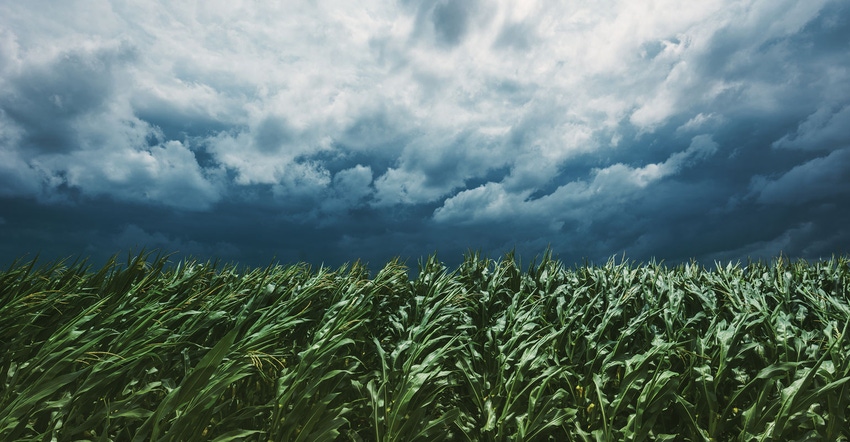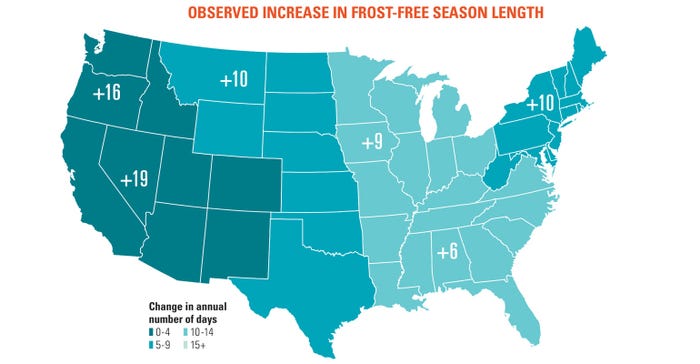November 1, 2018

Farming is always a gamble. The weather guarantees it. Problem is, the impact of climate change —springs that are cooler and wetter, harder winters, and droughts that are hotter and longer — makes timely and productive crop performance even less predictable.
But while growers can only hope weather patterns aren’t too extreme, many of their product and service suppliers have stepped up to provide tools that can help offset some of Mother Nature’s tantrums. Even as farmers do their part to weather-proof soils with cover crops and no-till, plant scientists, engineers and researchers craft seed, equipment and new technology to help counter climate concerns.
But will it be enough?

Weather extremes real
The debate on the cause of climate change is forever heated (pun intended). But whether it’s man-made, natural or both — it’s real. There are historical droughts that date back decades and centuries. The years 1988, 1995 and 2012 are more recent examples for the Midwest. And add part of 2018 to the too-hot-for-comfort list.
The National Oceanic and Atmospheric Administration says this year the contiguous U.S. experienced the hottest May ever in the 124 years the government has been recording temperature. The average May temp was over 65 degrees F, which topped the old 1934 record of 64.7. It was 5.2 degrees above normal.
While growing seasons are longer, key growth periods often face more drastic weather. The U.S. Global Change Research Program notes the difference between the final 32-degree day in spring and the first 32-degree day in autumn has increased by nine days in the Midwest and 10 days in the Great Plains (see chart on Page 59). That was for a period between 1991 and 2012, relative to readings from 1901 to 1960. And how many times have we heard stories about 5-inch rains that fell in less than an hour?

“Seed companies have been focusing on yield and yield stability by way of stress tolerance,” says Mark Licht, Iowa State University Extension cropping systems specialist. “This is pretty noticeable when we have dry climate conditions.”
More tolerant seed
Seed researchers are working to tackle weather issues. Consider that hottest-May-ever statistic. Better seed that can handle a harsher climate likely has had something to do with USDA in October estimating the 2018-19 U.S. corn yield at 180.7 bushels per acre.
Ever since hybrid corn seed and advanced soybean technology took off in the 1960s, seed companies have been breeding seed lines that can better handle changing environments, with more lines of maturity and drought tolerance.
“Seed companies have been focusing on yield and yield stability by way of stress tolerance,” says Mark Licht, Iowa State University Extension cropping systems specialist. “This is pretty noticeable when we have dry climate conditions.”
Seedling vigor in cool, wet springs is equally important across much of the Corn Belt. Hybrids that have high stress tolerance and, therefore, yield stability do tend to have benefits, as increased spring climate variability is becoming more of a normal occurrence, he says.
Tony Klemm, global corn portfolio leader with Corteva Agriscience, says, “Multiple or extended drought periods can result in significant yield loss, even though today’s corn hybrids are much more tolerant than those of the past.”
He notes that since the 1950s, Corteva’s overall seed breeding program (which includes Pioneer and Mycogen seed) has seen corn yields double per inch of water used.
Drought-tolerant corn hybrids bred by university researchers in the 1980s and ’90s for typically drier regions in the Southwest added proven germplasm to benefit more Northern producers.
Better drought-tolerant seed varieties from Monsanto, Corteva, other large and regional seed companies, and new kids on the block like Indigo Ag and Inari give growers more options to prepare for the next hot May, dry July or long growing period that bumps into late fall.
Seed protection
The advent of seed treatments provided better methods of getting a good stand, despite colder, wetter Aprils. Disease and insect pressure on seed and seedlings creep into many fields, especially those with a history of poor drainage and previous infestations.
“Companies have long been developing seed treatments to help protect seedlings from disease pathogens and insects,” Licht says. “Because of cool or wet conditions between planting and early vegetative growth, it is more important to make sure fungicidal seed treatments are used to protect seeds and seedlings that may not have vigorous growth.
“This spring there were cornfields planted around April 12 where the seed emerged at the same time as corn planted in late April. Fungicidal seed treatments help ensure adequate stand establishment in adverse conditions.”

“We’re working within a holistic and unusual blend of four disciplines to develop a seed that takes less time and less money,” Julie Borlaug says.
Julie Borlaug, granddaughter of the late Norman Borlaug, legendary plant breeder known as the father of the “green revolution,” is involved with a new company, Inari. She says Inari is focused on transforming plant breeding.
“We’re working within a holistic and unusual blend of four disciplines to develop a seed that takes less time and less money,” says Borlaug, who has heavily promoted genetic modifications to improve ag production and feed more people worldwide. “We employ biology, computational agronomy, data sciences and software engineering to create a seed customized for a farmer’s specific crops and environment, such as changing soil health, weather, drought conditions or new diseases.
“The best analogy to Inari’s approach is to the technologies being developed in life sciences and biomedicine using the unique genome of an individual to make customized improvements to their health. We are applying that approach to make improvements in seeds.”
Another way growers can battle environmental stress is Indigo Ag, which contracts with farmers for treated seed and in-season agronomic services. Indigo’s core product is a microbial seed treatment designed to improve a crop’s yield when facing environmental stress, says company founder Geoffrey von Maltzahn.
Growers get seed treated with the microbial product. At delivery, they receive a premium for grain they produce. Indigo then uses production data from contracted farms to enhance its overall program.
Weather-tailored equipment
Ever since farmers sold their oxen and mule teams and bought tractors, equipment manufacturers have provided them new products that cover more ground in less time. Wider, faster and more precise planters are helping tame spring planting season, says Gene Takle, ISU professor of atmospheric science.
“Planting windows are smaller in April, May and June due to more precipitation events and more precipitation per event,” Takle says. “Planters that are wider, or can be pulled across the field faster, shorten the planting time. That allows farmers to plant the same or more area in less time. They can cover more acres per hour.”
More advanced harvest equipment can also help growers get crops out of the field in a timely manner. Extended rain or snow events are the exception. Even so, wider soybean heads allow farmers to harvest more acres per hour in fall, when excessive dew periods caused by climate change are shortening the period when soybeans are dry and suitable for harvest.
Strip-till systems have allowed growers to use more cover crops, which along with more residue left from the previous year’s production, helps protect against 5-inch rains. Better field tiling systems also help growers manage runoff.

“Planters that are wider, or can be pulled across the field faster, shorten the planting time,” Gene Takle notes. “That allows farmers to plant the same or more area in less time.”
Advanced precision ag
Since the first autosteer systems hit the turn row in the 1990s, computers have played a wider role in the science of farming. With precise guidance systems, those strip-till planters can nearly place seed within an eyelash of where it’s needed.
Ever-improving farm software does much of the planning for its users. Infrared technology using cloud-based software helps identify specific fields and their production history. Software can also ID areas within a field that require more or less nitrogen, phosphorus or other nutrients than an area just a few rows away.
“Where precision technology comes into play is by more adequately allowing for precision placement of seed, seeding rate and other products to remediate crop issues due to variable weather,” Licht says.
ClimateFieldView, from The Climate Corporation, is among software tools designed to help growers manage nutrients and improve crop production. Using a tablet, smartphone or computer, growers can view nitrogen levels based on applications, crop stage and weather. The tool can help determine the right time and rate of nitrogen to apply.
Such tools can help manage around the weather. But with margins already tight, will paying higher seed tech fees or upgrading to better climate management tools storm your budget?
“This is a tough decision for growers, but sometimes it takes money to make money,” Licht says.
Nothing is foolproof
Despite these advances, Mother Nature can, and often does, have the upper hand. While much progress has been made in the last six years, it’s still not clear how much yield to expect from today’s drought-tolerant hybrids if we see another long-term historic drought such 2012’s.
It is crucial to understand that drought-tolerant hybrids will not produce if subjected to terminal drought, say Kansas State University researchers. They will not thrive when moisture is severely limited, especially in dryland systems.
In other words, you can’t fool Mother Nature all the time. But an extra day or two to get protected seed planted in the right soil conditions, or harvested before precipitation persists, can temporarily put climate change in its place — at least, for a while.
Stalcup writes from Amarillo, Texas.
About the Author(s)
You May Also Like




